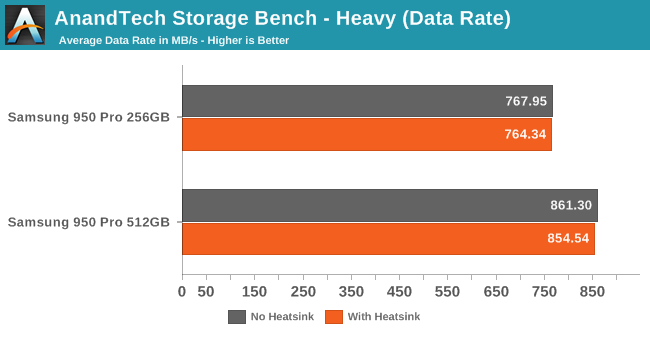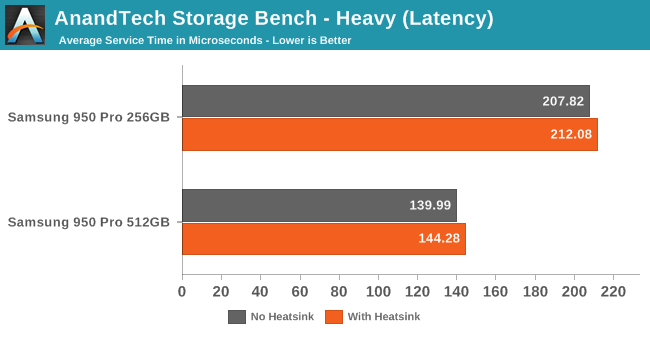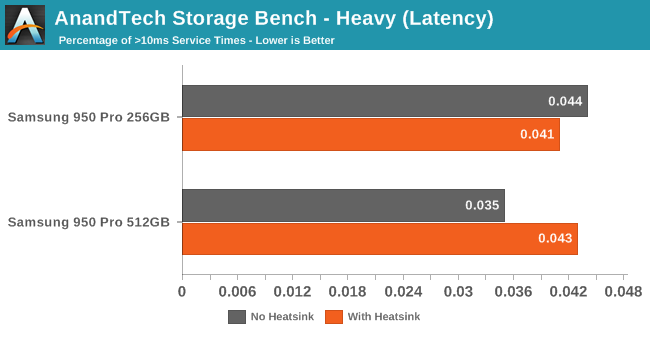The Angelbird Wings PX1 M.2 Adapter Review: Do M.2 SSDs Need Heatsinks?
by Billy Tallis on December 21, 2015 8:00 AM ESTAnandTech Storage Bench - Heavy
Our Heavy storage benchmark is proportionately more write-heavy than The Destroyer, but much shorter overall. The total writes in the Heavy test aren't enough to fill modern SSDs, so performance should never drop all the way down to the steady state. This test is far more representative of a power user's day to day usage, and is heavily influenced by the drive's peak performance. The Heavy workload test details can be found here.



For the Heavy test, we see a bit of a trend of the heatsink having a very slight negative impact on performance. The 256GB drive reverses the trend when looking at the number of outliers, and the disparity for the 512GB drive appears larger than for the previous test, but we're only looking at a difference of a few hundred operations out of an hour-long test.










69 Comments
View All Comments
FunBunny2 - Monday, December 21, 2015 - link
^^that's funny
Breit - Saturday, December 26, 2015 - link
You mean something EKWB did for the Intel 750?http://www.ekwb.com/news/638/19/EK-is-releasing-In...
:D
meacupla - Monday, December 21, 2015 - link
I think this is where all those low profile, frag tape backed, RAM heatsinks, that came along with aftermarket GPU coolers, will come in handy.ironwing - Monday, December 21, 2015 - link
I wonder how much heat 25 LEDs add to a heat sink?mostlyharmless - Monday, December 21, 2015 - link
Yeah, and aren't the fins supposed to be external instead of internal?Billy Tallis - Monday, December 21, 2015 - link
They're really more like ducts than fins as designed. What air does manage to enter the heatsink will not all flow across the entire drive. Some of the fresh cool air will bypass part of the drive, and some of it will just be cooling the heatsink itself. It looks like a design that would be very effective with a lot of airflow, but the intake is pretty small.Billy Tallis - Monday, December 21, 2015 - link
The LEDs draw about 2W. Calculating how much of that gets converted to light that escapes the heatsink is left as an exercise for the reader.MrSpadge - Monday, December 21, 2015 - link
10 - 20 mW each.r3loaded - Monday, December 21, 2015 - link
So what we really need is the 950 Pro in a 2.5 inch drive and the U.2 interface. The bonus is drive capacities of 1TB and maybe even 2TB.Impulses - Monday, December 21, 2015 - link
Great write-up Billy, I appreciate you running the full battery of tests again and re-addressing the Bench scores... A review of a heatsink feels somewhat incomplete without a single temperature measurement tho! SMART readings or something taken with a simple IR thermometer would've been helpful, specially to the kind of DIY'er that's likely to buy this. I'm curious if i can replicate comparable results with a simple stick on heatsink and some airflow, it's particularly relevant for those of us with multiple GPUs where the add in card might put the drive in just as bad of a spot but the M.2 slot might be exposed to more airflow.